G-Star’s Art of RAW campaign film by Glassworks Amsterdam has caused somewhat of a stir since it was released last week. Now, Glassworks talks to fxguide about they made the fully-CGI film, which takes a journey behind the art and craft of the denim maker’s own clothing with a surprise bare-bones ending.
Designing the film
To match G-Star’s raw-denim style – a specific woven structure and indigo-dyed natural cotton with typical yellow double stitching and rivets – Glassworks director Ruediger Kaltenhauser chose to focus on these very recognizable features. “Right from the beginning my idea was to focus on these elements and to bring out the inherent beauty of the materials – soft natural cotton, the slight shine to the raw denim surface, metallic rivets,” he says. “I wanted the compositions to focus on the each specific part of the denim-making process, without distractions from unnecessary background detail. To support this I opted for a toned down colour pallet: dark blue, whites and black, with a splash of warm colour coming from the cotton leaves, the orange thread, and the rivets.”
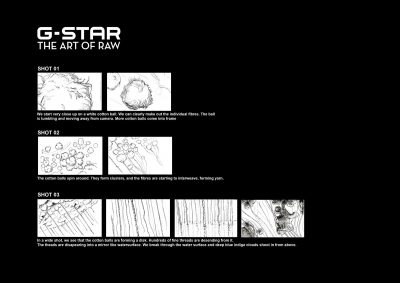
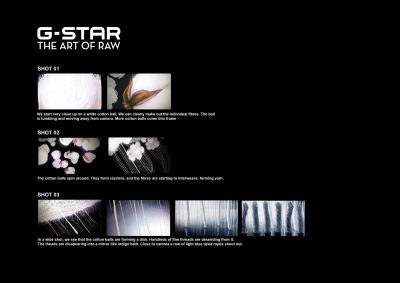
The end result was a clean, graphic layout with co-ordinated and choreographed animation. “I further emphasized the focus on detail by using a macro photography shooting style,” adds Kaltenhauser.
“Our goal was to create the feeling of a journey with a naturally flowing edit from one sequence to the next. During the storyboarding and 3-D layout stages we were in close contact with one of G-Star’s denim specialists, to make sure our film remained faithful to their actual processes. As a result, we changed the dying sequence completely at the layout stage because it was too far away from G-Star’s dying procedure.”
Nice threads
As the fabric takes shape, the film showcases the denim manufacturing process with macro views of the cotton and threads. Different sequences were actually handled by separate artists who took ownership of the whole shot from modeling, rigging, texturing to rendering.
The cotton sequence was created largely using Softimage ICE strands. “The weaving sequence uses curve-deformed geometry for the threads, whereas the denim fabric seen in the stitching and button shots was created using hires textures and displacement maps,” explains Kaltenhauser. “To maintain a clear continuity throughout the constantly changing threads, each artist always referred back to the our hi-res macro photographs of the real G-Star denim, rather than trying to match what another artist had made.”
Take a bath
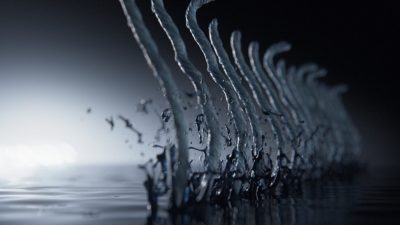 The indigo-dye process is simulated with the threads going through a bath process. For the first liquid shot, when the cotton rope dives into the dye, Glassworks used a Softimage ICE system to detect contact points and create ripples. The second dye shot, with the rope arcs, was originally based on two RealFlow simulations – one for the water surface, and one for the splashes. “We later decided to change the splashes to a pre simulated Lagoa splash,” notes Kaltenhauser, “using the em-polygonizer to cache it. This way we could easily position and time the splashes for each rope. Lastly, for the close-up rope shot we used real footage of water droplets and composited them into the picture using Flame.”
The indigo-dye process is simulated with the threads going through a bath process. For the first liquid shot, when the cotton rope dives into the dye, Glassworks used a Softimage ICE system to detect contact points and create ripples. The second dye shot, with the rope arcs, was originally based on two RealFlow simulations – one for the water surface, and one for the splashes. “We later decided to change the splashes to a pre simulated Lagoa splash,” notes Kaltenhauser, “using the em-polygonizer to cache it. This way we could easily position and time the splashes for each rope. Lastly, for the close-up rope shot we used real footage of water droplets and composited them into the picture using Flame.”
Denim close-up
The macro denim and button shots were handled with traditional animation techniques. “We used curves with animated points and deformed our hi-res yarn onto these, animating it down the curve,” says Kaltenhauser. “For the faster sewing we used a different set-up, with one short piece of yarn per stitch, to avoid the yarn running through the completed stitches. The denim fabric was animated using a large stack of lattices. This way we could keep the animation independent from the geometry topology.”
“Earlier versions of the denim fabric were made from actual woven geometry with macro photographs of denim as textures,” continues Kaltenhauser. “This hi-res geometry proved to be very difficult to handle once in production, so we extracted a displacement map from the modelled fabric and were able to get the exact same look using low-res grids. In addition to the denim shader, there’s a little bit of hair on the grids to break up the surface. The button and rivets were modelled and textured in a very straightforward way, again using macro photos of the real G-Star objects as an essential base.”
The skeleton reveal
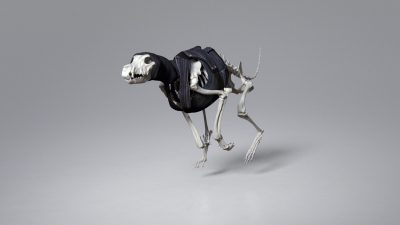 The macro journey across the denim is finally revealed to be the surface of a jacket for a dog skeleton, which makes leaps into action. Glassworks scanned a physical skeleton using a NextEngine 3D scanner. “The scanner was placed on a tripod and moved around the body-skeleton in small intervalls to get scans from various angles,” explains Glassworks 3D artist Markus Geerts. “For the head we placed the skull on the tripod and rotated that. I stuck lots of tiny colored putty-spots on the skeleton to get reference points for the stitching of the scanned slices in ScanStudio HD. The hi-res mesh was exported as .obj and then used as a base for the different bone-models.”
The macro journey across the denim is finally revealed to be the surface of a jacket for a dog skeleton, which makes leaps into action. Glassworks scanned a physical skeleton using a NextEngine 3D scanner. “The scanner was placed on a tripod and moved around the body-skeleton in small intervalls to get scans from various angles,” explains Glassworks 3D artist Markus Geerts. “For the head we placed the skull on the tripod and rotated that. I stuck lots of tiny colored putty-spots on the skeleton to get reference points for the stitching of the scanned slices in ScanStudio HD. The hi-res mesh was exported as .obj and then used as a base for the different bone-models.”
Softimage was then used to model the rig, with displacement maps painted in Mudbox. “The denim jacket was then attached using multiple cage deformers and Syflex cloth simulation,” says Kaltenhauser. “We tested many different timings and speed-ramps for the skeleton dog animation. In order to quickly get results, we plotted a super slow-motion animation of the skeleton dog, and then re-timed the caches using a single animation curve.”
Where to see The Art of RAW
The film will be screening on G-Star’s website (www.g-star.com), in cinemas and in-store, with the skeleton being a central image of The Art of RAW print campaign, now brought to life by Glassworks. “We wanted to create a dramatic journey through G-Star’s denim-making process – or a stylised version of it – to create a magical and moody world, within which the viewer can witness everything from the untreated cotton burs all the way to the final denim object,” says Kaltenhauser. “We aimed to leave the viewer with a sense of the beauty of the raw-denim material itself, not just the end product.”
Credits
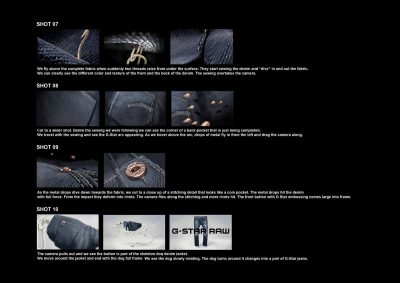
Production Company: Glassworks Amsterdam
Director: Ruediger Kaltenhauser
3d Artists: Markus Lauterbach, Tim Borgmann, Markus Geerts, Nick Smalley, Tim Bolland, Dan Hope, Chris Wood
Flame artists: Kyle Obley, Lise Prudh’omme
Flame Assist: Bob Roijen
Grading: Scott Harris
Executive Producer: Jane Bakx
Client: G-Star RAW
Concept: G-Star RAW creative team
Music: Skrillex

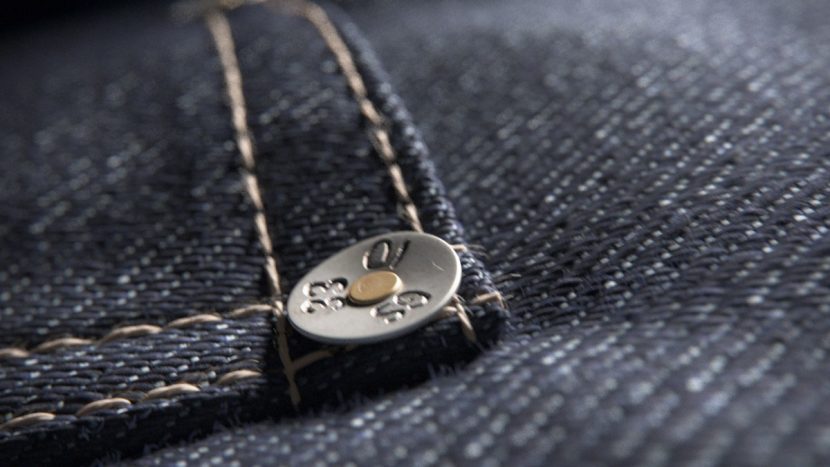
Fantastic work! I loved every pixel of it. 🙂 Kudos.
looks great, well done.
The jean looks great, all the rest looks 3d, and abuse macro view can just hide this!